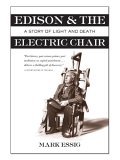Edison & The Electric Chair: A Story of Light and Death was one of the more interesting books that I have read in a very long time. And, it was highly pertinent to the current debate over the death penalty (in the US).
Amazingly, this is Mark Essig’s first title. I would expect a book with 46 pages of endnotes to be dry and scholarly instead of alive and riveting. I wouldn’t have expected a discussion about the nature of electricity to have been simple to understand, yet it was. I also would not have expected a discussion about death and the death penalty to be handled so clearly, concisely and competently. Such a discussion could have delved into excessive details or it could have been superficial. Essig did a great job of navigating the pitfalls while providing the necessary details to make the point.
Don’t assume that this book was dry and academic. Hardly. If anything, it was to lively considering the subject….
For those of you unfamiliar with Edison’s influence on the choice to use an electric chair for execution, let me give you the highlights. Edison backed direct current (DC) while Westinghouse chose alternating current (AC). Both are different approaches to delivering electrical current for use. Both have strengths and weaknesses. When Edison was queried about using electricity for execution, he originally declined the question as he was opposed to capital punishment. When pressed, he argued for the use of AC generators with the idea that their use would scare people away from AC into the arms of his DC. Unethical? Certainly. But, as Essig points out, Westinghouse was worse. Edison gets a bad rap today for trying to smear Westinghouse, but Westinghouse disregarded the public’s welfare and bribed plenty of legislatures/judges to bypass Edison. Neither was a saint…. Anyway, the debate was only part of the point of the book. The real purpose of this book is to look at execution.
Essig begins with a discussion of the history of electricity and the history of capital punishment in the US. Capital punishment (i.e. hanging) was designed as a ceremony to educate the public about the wages of sin. That attempt flopped. By the early 1800’s, execution was a festival or a carnival. People came to the execution the same way that they go to see the latest summer blockbuster films. This distressed the leaders who worked to prevent this occurrence. In fact, the migration of the execution to the prison yard was to prevent this carnival atmosphere.
Concurrently with this shift in execution came the introduction of pain killers. This revolutionized the way people approached life. Prior to pain killers, pain and death were a part of life. Not only were they expected, but no one thought about them. Once they could be avoided though, that attitude changed. Now, it became the mission of people like the newly formed SPCA to prevent pain in all animals (humans were included as Darwinian thought was developing strongly).
Mix both developments throughout the mid-1800s and shake. What comes about? A new approach to execution that seeks to prohibit cruel and unusual punishment. When deciding on how to execute someone via electricity, there were some interesting discussions. Should the person stand? There is dignity in that but, they might fall away from the contacts. What about laying down? That was too clinical and undignified; to much like having experimentation on the condemned. (At this time, the idea of experimentation on people was more frightening then the death penalty itself.) So a chair was decided as a compromise to practicality and dignity.
Was electricity to cruel a manner for execution? If I had to guess, I would have said no. Then again, I suspect that most people should die in the same manner they killed others, but that’s me. I would never have guessed that electrocution would have been botched as often as it was. I would never have guessed that EVERY form of execution has been botched countless times. But so it is.
Still the fact remains: execution is commanded by God and is the duty of the state. However it is done, and a civilized manner like lethal injection is best, execution should still be done. Today, using the same arguments that the anti-death penalty advocates put forth in the 1880’s and 1890’s, lethal injection is currently being debated in our courts as excessively cruel. I find this intriguing. Mix another hundred years of pain killers, Darwinian thought, and the belief that man can be trained like an animal and shake it up. Now, the most painless death we can develop is still too painful. Or at least it has the possibility of extreme pain.
So we should do away with the death penalty because it could be painful? What about restitution to the families of the victims? Of those murdered? Should we put these killers in a penitentiary forever? Does the penitentiary actually develop penitence? So what should be done?
Essig doesn’t preach and give us the answers. He lays out the facts and leaves the decision to you. But I would recommend that you read this book in light of the current debates. Personally, I have moderated my views on execution somewhat as a result of this book. I am not in favor of using public punishment as a method to educate the masses. Its been tried and failed in a more religious America to boot. No, I am not in favor of brutal punishments. History has shown that both of these tend to develop an appreciation for violence and we have plenty of that now. No, I am in favor of the death penalty, but done humanely and quickly.
You?

